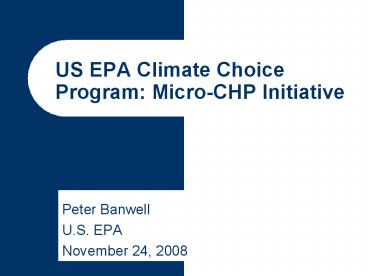US EPA Climate Choice Program: MicroCHP Initiative - PowerPoint PPT Presentation
1 / 19
Title:
US EPA Climate Choice Program: MicroCHP Initiative
Description:
Look at the Technology Commercialization Process ... Need different tools/policies/ market interventions. Technology Introduction Challenge: the Chasm ... – PowerPoint PPT presentation
Number of Views:64
Avg rating:3.0/5.0
Title: US EPA Climate Choice Program: MicroCHP Initiative
1
US EPA Climate Choice Program Micro-CHP
Initiative
- Peter Banwell
- U.S. EPA
- November 24, 2008
2
Agenda
- Overview of Climate Choice program
- Micro-CHP Discussion
- EPA Activities to Date
- Overview of Draft Criteria
- Timeline and Next Steps
3
Look at the Technology Commercialization Process
- Important different phases
- Different costs/ risks and benefits
- Important different players
- Need different tools/policies/ market
interventions
4
Technology Introduction Challenge the Chasm
- Over hyping not the solution
- Disillusionment follows the hype
- Working together to make technology relevant to
todays buyers is the answer
Gartner, 1995
5
Role of ENERGY STAR
- ENERGY STAR
- mass market consumer
- cost-effective (2 to 3 year
- payback)
- two-thirds of ENERGY STAR
- products have no incremental
- cost
- proven technology
- no sacrifice in performance
- reliable savings easy design,
- installation, and maintenance
6
Role of Climate Choice
- ENERGY STAR
- mass market consumer
- cost-effective (2 to 3 year
- payback)
- proven technology
- no sacrifice in performance
- reliable savings easy design,
- installation, and maintenance
- Climate Choice
- new recognition program
- early adopters /
- environmentally conscious
- consumers
- longer payback
- more complex regional / installation/
- maintenance / performance issues
7
Program Benefits
- Recognition
- Website
- Trials promotion
- Climate Choice logo
- Tailored technology assistance
- Clearing unintended regulatory barriers
- Identifying customers partners
- Providing opportunities for information sharing
through existing CPPD networks - ENERGY STAR candidate development
8
Stakeholder participation consensus building
- EPA experts and external stakeholders participate
in program design and criteria selection - Review of draft performance requirements
- Partnership opportunities with utilities and
other program implementers - Pilot projects, case study development,
co-promotion - Access to energy saving tools and technology
assessments
9
Criteria
- Commercially available, but not widely adopted (lt
5 market share) - Preferably offered by more than one supplier, but
not required to be - Demonstrated environmental performance third
party verified to agreed standards - EPA could help facilitate standard development
- Likely to significantly reduce greenhouse gases
at competitive costs - Capable partners, adequately financed,
established business record - Challenges matched to EPA competencies and
appropriate roles. - Criteria are elaborated in Climate Technology
Conference Findings - http//www.epa.gov/cleanenergy/climate/
10
Selection Review
- Learning from the best
- Open application process
- Selection based on annual expert review
- Sector-based expert panels nominate promising
technologies - CPPD managers and external expert review panel
score proposals
11
Technology Evaluation
- Technology Readiness (25)
- Company Capability (20)
- Environmental Benefits (35)
- Third party testing and validation (20)
12
Residential Cogeneration (mCHP)
- EPA has some experience with technology through
EPA CHP Partnership program - Technologies most suitable to residential app.
- IC engine, stirling engine, fuel cell systems
- Space heating and/or water heating applications
- Interest in residential and small commercial
applications (lt5 kW) - Plans for U.S. commercialization
13
Activities to Date
- Created micro-CHP savings model
- Shared with several industry stakeholders for
input - Developed Technology Action Plan
- Held discussions with key manufacturers for U.S.
market - Released draft criteria for Climate Choice
participation
14
EPA CHP Model
15
Climate Change Specification
- Technologies must meet minimum criteria to be
considered - Documentation requirements to validate claims
- Technical performance
- Key criteria is carbon emissions reduction
- Other environmental and quality criteria
- Company requirements
- Sufficient resources to distribute in U.S. market
16
Draft Performance Criteria
Overall CHP Efficiency (Net CHP Electric
Output CHP Thermal Output Used)/CHP Fuel Input
all calculated in Higher Heating Value (HHV)
17
Draft Performance Criteria cont.
Note Comments on draft criteria can be sent to
Rebecca Duff at rduff_at_icfi.com
18
Next Steps/Timeline
- December Finalize and release micro-CHP
performance criteria - Include pilot program requirements document
- December January Identify potential pilot
project/participants - Look to partner with utility/regional program
- January March Participate in pilot project,
collect/review results - May Release/post case studies
19
Contacts MCHP Initiative
- Peter Banwell, 202-343-9408 banwell.peter_at_epa.gov
- Bruce Hedman, ICF International, bhedman_at_icfi.com
- Rebecca Duff, ICF International, rduff_at_icfi.com
- Additional Climate Choice information
http//www.epa.gov/cleanenergy/climate/

